Our Verdict
With a striking angular design and a touchscreen built into the front, MSI's Trident X2 is a little different to your typical gaming PC. This particular version is also packed with ultra high-end hardware, including an Intel 14900KF and Nvidia RTX 4090, giving it a high price, but other configurations are available. Its reversed motherboard layout and ducted graphics card cooling means it remains mostly cool and quiet with all that power. Fans of RGB and glass windows to show off your PC's interior will have to look elsewhere, but this is otherwise a solid option.
- Clever cooling setup
- Touchscreen is an interesting addition
- Masses of gaming performance
- No side glass panel or internal RGB
- Can't configure spec at checkout
- Touchscreen isn't all that useful
The MEG Trident X2 is a long-running line of gaming PCs from MSI that’s available in a range of configurations, all based on a mid-size tower case with an aggressive angular design. The MSI MEG Trident X2 14th gen is the latest update to that case design, with a touchscreen on the front and a new range of current top-end hardware, including Intel’s latest 14th gen Core processors.
The configuration we’re reviewing includes an Intel Core i9-14900KF and an Nvidia GeForce RTX 4090, making this MSI machine comfortably the most capable gaming PC we’ve yet reviewed. That’s not all that’s required to secure a spot on our best gaming PC guide, though, so let’s see what else this PC has to offer.
MSI MEG Trident X2 specs
| CPU | Intel Core i9-14900KF |
| Graphics card | MSI Nvidia GeForce RTX 4090 Ventus 3X |
| RAM | 64GB DDR5 |
| Motherboard | MEG Z790 Trident X2 14 |
| Storage | 2TB Samsung 980 Pro M.2 SS, 2TB Seagate ST2000DM008 3.5-inch hard drive |
| PSU | MSI MAG A1000G PCIe 5 (1000W) |
| CPU cooler | 240mm MSI AIO liquid cooler |
| Networking | 1 x 2.5Gb Ethernet, 1 x 1Gb Ethernet, Wi-Fi 7 |
| Extras | Touchscreen on front of case |
| Case | MSI Trident X2 |
| Operating system | Windows 11 |
| Front ports | 2 x USB-A 3.1, 1 x USB-C, headphone out, line/mic in |
| Rear ports | 7 x USB-A 3.1, 2 x USB-A 2.0, 1 x USB-C, 5 x 3.5mm audio, 1 x optical audio, 2.5Gb Ethernet, 1Gb Ethernet, HDMI (motherboard), PS/2 for mouse/keyboard, 2 x DisplayPort (graphics card), 2 x HDMI (graphics card) |
| Warranty | One-year parts and labor |
| Price | ~$4,000, £3,999 |
As with most gaming PCs, the exact specs of the Trident X2 will depend on the version you buy. In theory, these systems start at relatively modest prices and specs, with last-gen versions including Intel Core i7-13700KF CPUs and Nvidia RTX 4070 Ti GPUs, with a starting price of $1,799.
However, the only brand new 14th gen system in stock at the moment is this top-tier version we’re reviewing. That means you get an Intel Core i9-14900KF (which is basically identical to the Core i9 14900K, just without integrated graphics) and an Nvidia RTX 4090. That’s well over $2,000 worth of components right there, so it’s no surprise the whole system cost tops out at over $4,000.
For that cash, you also get a huge 64GB of DDR5 RAM allocation, along with a decently capacious and speedy Samsung 980 Pro 2TB M.2 SSD, along with a 2TB Seagate ST2000DM008 hard drive. The latter is an interesting option, as a capacity of just 2TB could easily have been met with a cheap SSD, which would’ve ensured a faster drive. It may only be a drive meant for secondary storage but we’d rather have it be fast than not.
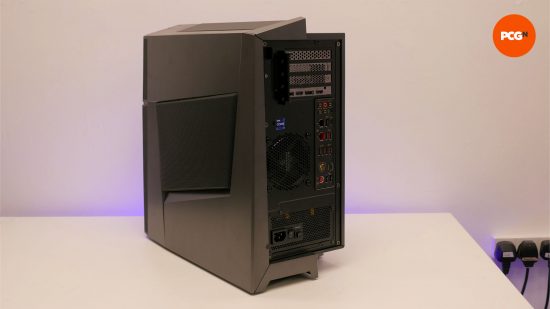
If you’re going to include a hard drive in a system of this price, we’d expect one that’s at least 4TB and more like 8TB. It’s a minor grumble, though, and a relatively easy upgrade to add another drive yourself.
The motherboard here is MSI’s own MEG Z790 Trident X2 14, which appears to be a pared down (stylistically, at least) version of its various MEG Z790 boards, most of which have far more in the way of fancy IO shrouds, expansion slot covers and the like. This is a simple black board, but with plenty of practical features.
It provides absolutely loads of connections, with a massive count of seven USB-A 3.1 ports, along with two more USB 2 sockets and a USB-C port too. You also get two Ethernet connectors – one 2.5Gb and one 1Gb – and you even get a PS/2 port for connecting really old keyboards and mice.
There’s also an HDMI port on the motherboard, but MSI has sensibly blocked this off as the CPU here doesn’t include integrated graphics, so the port doesn’t work anyway. Instead, you get two DisplayPort and two HDMI sockets on the graphics card. The card is an MSI GeForce RTX 4090 Ventus 3X with a huge triple-slot cooler and three fans.
You get four RAM slots, with only two occupied by our 64GB configuration, so there’s an easy upgrade to 128GB if desired, though 64GB is more than enough for most people in our experience. Top-tier onboard audio is also present, with six analog outputs and two digital outputs. Meanwhile, the motherboard BIOS is a fairly standard variant of MSI’s other motherboard BIOSes, offering plenty of overclocking and other tweaking options.
MSI MEG Trident X2 design
This PC’s design is an interesting mix of outlandish and very sensible. Like many non-custom-made gaming PCs, such as those from Alienware, MSI has avoided hazardous building materials such as tempered glass. As such, you don’t get the RGB-filled glimpse into the interior of your PC that many of the best PC cases provide.
Instead, you have sturdy metal and plastic side panels with various ventilation grilles dotted around them, with RGB lighting instead confined to three slashes on the front of the case.
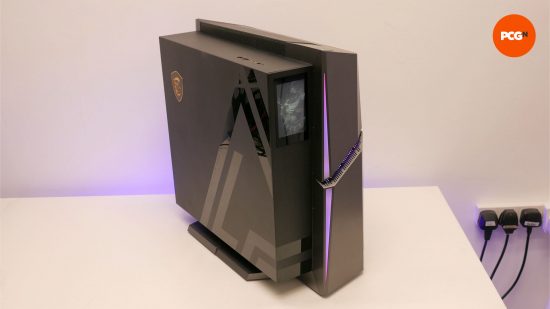
Also on the front of the case is a small LCD panel that, by default, just shows various MSI logos and related animations in black and gold/white. However, tap the screen and it brings up access to a host of functions, from volume controls and RGB lighting adjustment, to system monitoring and system profile switching.
It’s a neat little extra, though we suspect many buyers would rather save $100 or so and not have it – there didn’t seem to be a killer function that really made it feel like it was a feature we’d use day to day. It also has nowhere near the image quality or versatility as the screen on the Hyte Y70 Touch, for instance, as that can act as a full second screen.
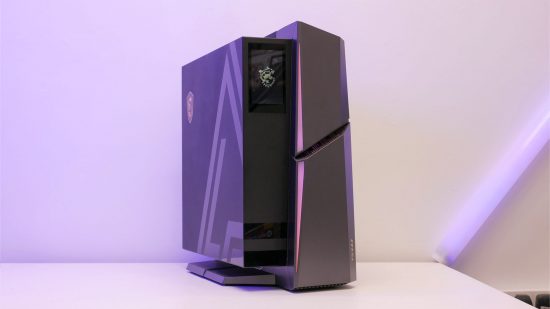
As for the rest of the case, it’s striking in its sharp-angled form. It’s certainly a little different to the average plain cuboid with a glass side panel. It isn’t quite to my taste, though your mileage may vary, of course.
The left side of the base has a separate foot with a gap up to the rest of the case. Bizarrely, though, MSI hasn’t used this space to add extra ventilation areas – it’s just an aesthetic addition. It’s a similar situation on the top of the case, where the broken-up, angled top surface doesn’t really serve a purpose, although here MSI has added a ventilation grille on top of the right surface.
Speaking of ventilation, this PC has an interesting cooling configuration, and in fact the whole system is set up a bit differently to most PC systems. The whole case has been flipped round in comparison to a normal one. Instead of the motherboard sitting on the right, it sits on the left. This in turn flips the graphics card from being on the bottom to being on the top.
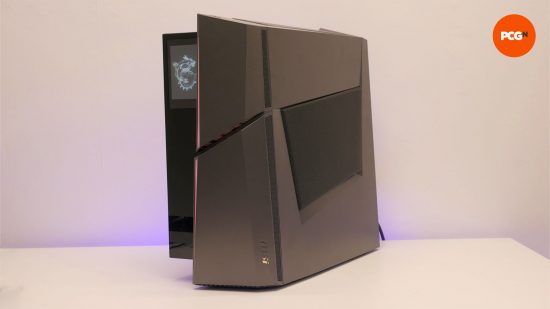
Using this arrangement to its advantage, MSI has the cooling system set up so that cool air is drawn in from the top ventilation grille and pulled straight to the graphics card via a plastic duct inside. Oddly, despite using this clever ducting for the intake, no accommodation is made for the hot air coming off the graphics card – it’s all just left to fill the case.
Instead, expelling most of the hot air out of the case are two fans that sit on the radiator for the AIO cooler. The radiator in turn mounts to a bracket that sits across the middle of the case and pushes hot air out the right side panel. The overall setup results in cold air being pulled in from the top of the case and vented straight out the side, but with the air being pulled through the radiator already having been warmed by the graphics card. Just one other fan is included in the system, which is a 92mm exhaust fan at the back of the case.
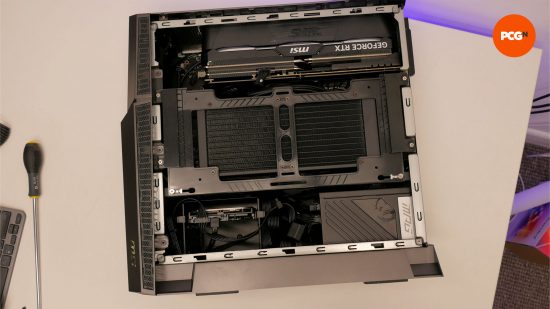
Accessing the inside of the case is fairly easy, for when you need to give the insides a dusting or make some upgrades. The right side panel slides off with the removal of three screws, then four more screws hold the AIO cooler radiator in place. With these screws undone you move the radiator out the way to access the motherboard with its M.2 SSD and RAM. Removing the graphics card is much more difficult, though, as it’s mounted on a custom support bracket and has the duct in the way, though it is still perfectly doable.
It’s also clear MSI doesn’t particularly want you playing around too much, as the screws here aren’t easy-to-access thumb screws, but instead very low profile ones that never seemed to quite fit any of my screwdrivers. Still, none of the insides are obviously proprietary and entirely locked down, so upgrades are an option.
MSI MEG Trident X2 setup & software
Initial setup of the Trident X2 is painless. It shipped with a reasonably up-to-date installation of Windows 11, and while it did jump straight into some system updates, they weren’t too obtrusive.
I was actually surprised by the relative lack of extra bloatware on the system and had to go searching for MSI’s Control Center software. This brings MSI’s various pieces of software together into one interface for hardware monitoring, system updates, and more. From here you can install MSI’s AI Engine, for instance, which will learn from your usage patterns and adjust system settings on the fly for you. There’s also the MSI Companion game bar overlay, the LAN Manager, AI Noise Cancellation Pro for microphones, and much more. It’s honestly all a bit too much, with it being rather confusing as to what’s a crucial feature for, say, driver downloads and firmware updates, and what’s AI fluff.
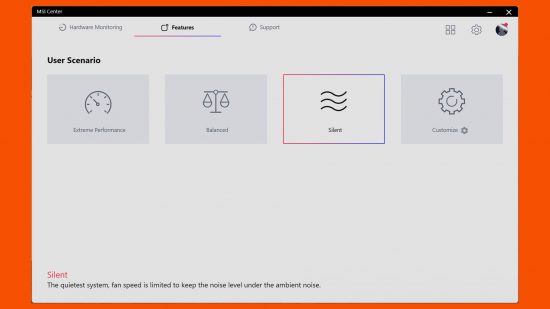
The most crucial and (thankfully) prominent feature, though, is the User Scenario section that lets you switch between Silent, Balanced, and Extreme system profiles at the touch of a button. The former prioritizes keeping fans spinning as little as possible, while Extreme overclocks the GPU and keeps the CPU pinned at top speed while letting the fans spin as fast as they like. As you might have guessed, Balanced sits somewhere in the middle.
Elsewhere, you get Norton 360 for Gamers antivirus installed but that’s about it – it’s quite a clean system that’s just ready for you to download your favorite apps and games and get gaming.
MSI MEG Trident X2 performance
As you’d expect from a system this packed with high-end hardware, the Trident X2 14th gen positively bullies our benchmarks. Firing up PCMark 10, this system cranked out huge numbers in every test, showing that every aspect of its setup is hugely fast.
That translates across all usage, from productivity and content creation to gaming, being just about as fast as a PC can possibly be. The SSD isn’t the absolute fastest available these days, but it’s still a very speedy drive that won’t hold you back in realistic everyday tasks.
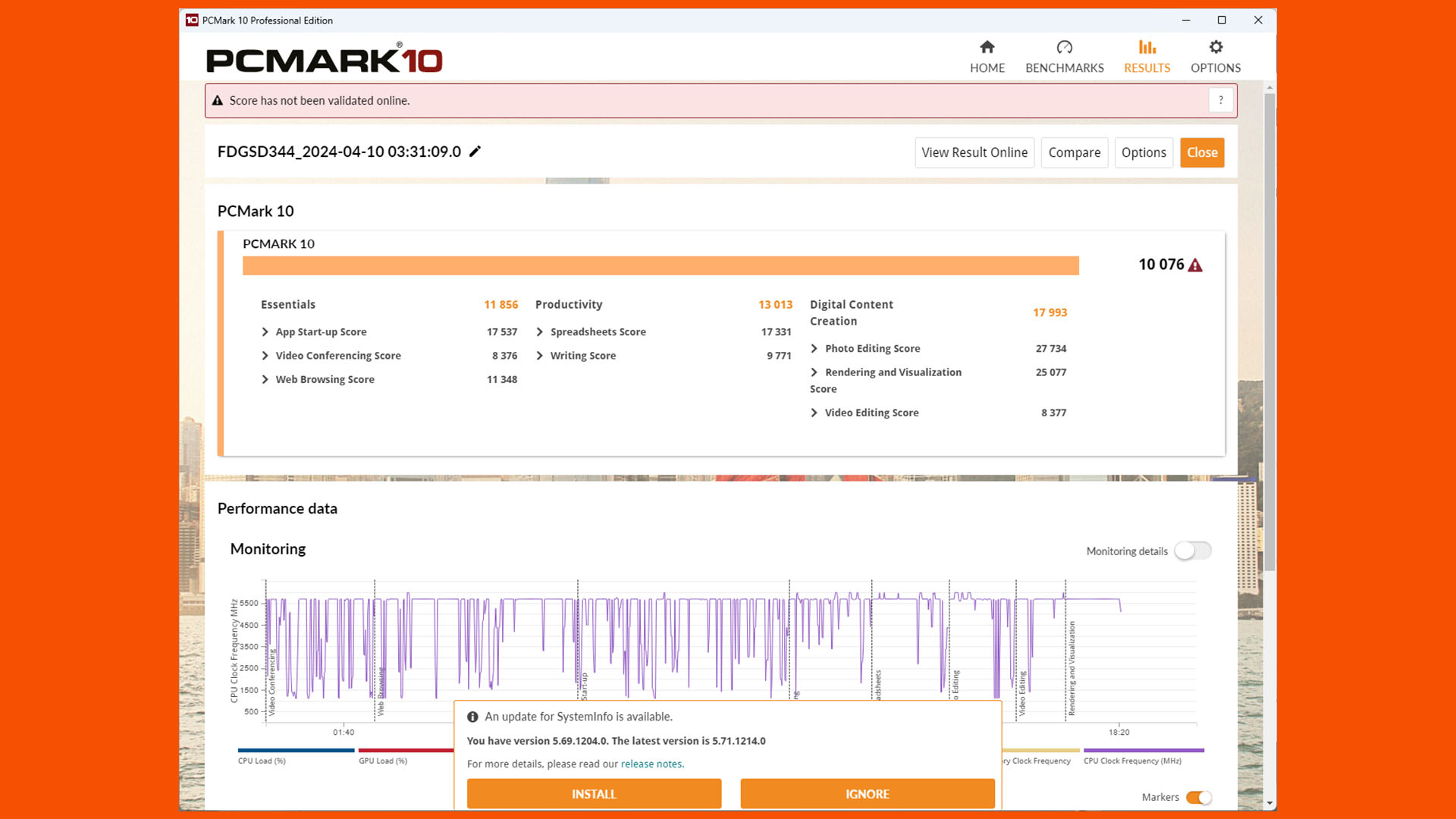
As for more gaming-specific benchmarks, in 3DMark’s CPU Profile test, this machine scored a huge 16,167 points in the 16-thread test, more than doubling the performance of the Core i5-13400F in the Maingear MG-1 Silver, for instance. In PCMark 10 this system as a whole also scores a huge 10,076 points, with very high scores in all aspects of performance. Intel’s 14th gen CPUs might sometimes be beaten for gaming performance by AMD’s 7000 series X3D chips, but for all-round capability – especially for multithreaded workloads, the 14900KF used here is a monster.
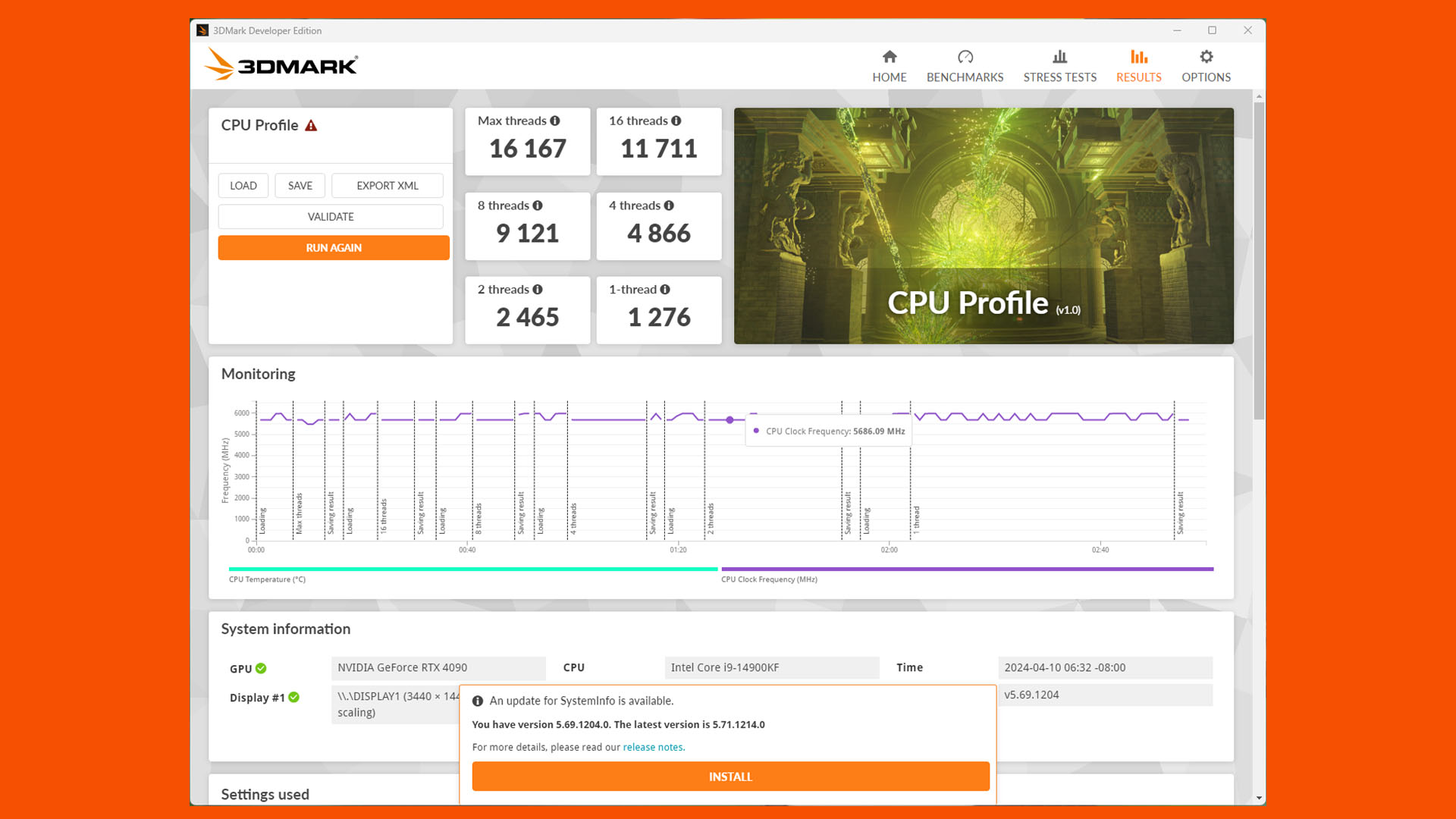
It’s a similar story in graphics tests, with the RTX 4090 in this machine delivering figures such as 9,864 points in 3DMark Speed Way and 17,629 points in 3DMark Time Spy Extreme.
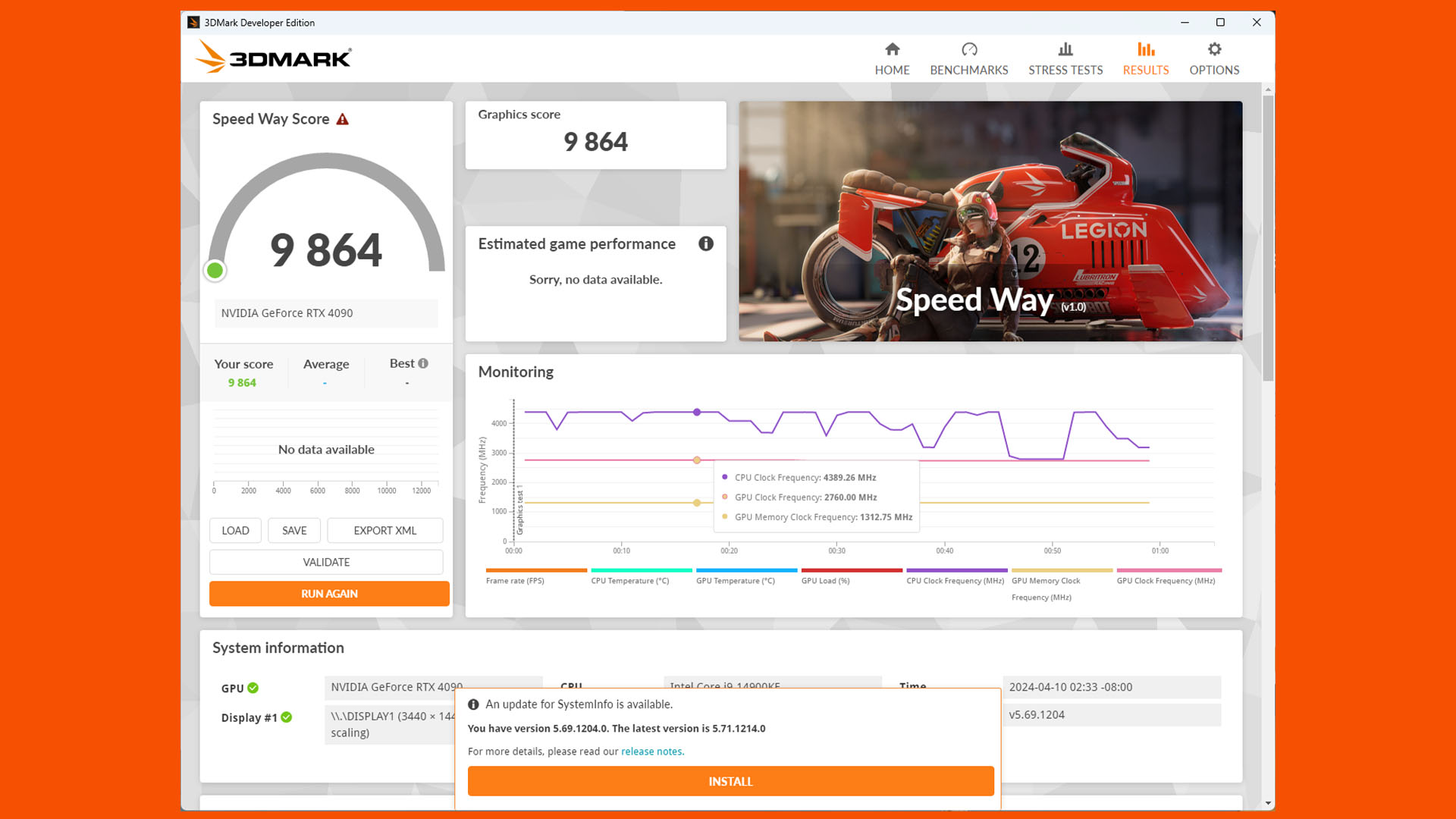
As for more real-world gaming tests, in our Cyberpunk 2077 benchmark, this machine will get you 127fps on average at 1440p with all the settings maxed out (other than ray tracing, which is on Ultra rather than Path Tracing, but still looks amazing). The minimum frame rate doesn’t dip below 105fps either, so you’ll have a consistently smooth time of it.
In Total War: Warhammer you’ll also get an average of 178fps with the game again set to its highest graphics settings at 1440p. Meanwhile, in F1 2023, you’ll hit a 157fps average with minimum frame rates of 142fps, again ensuring your view is always smooth, even if the ride isn’t.
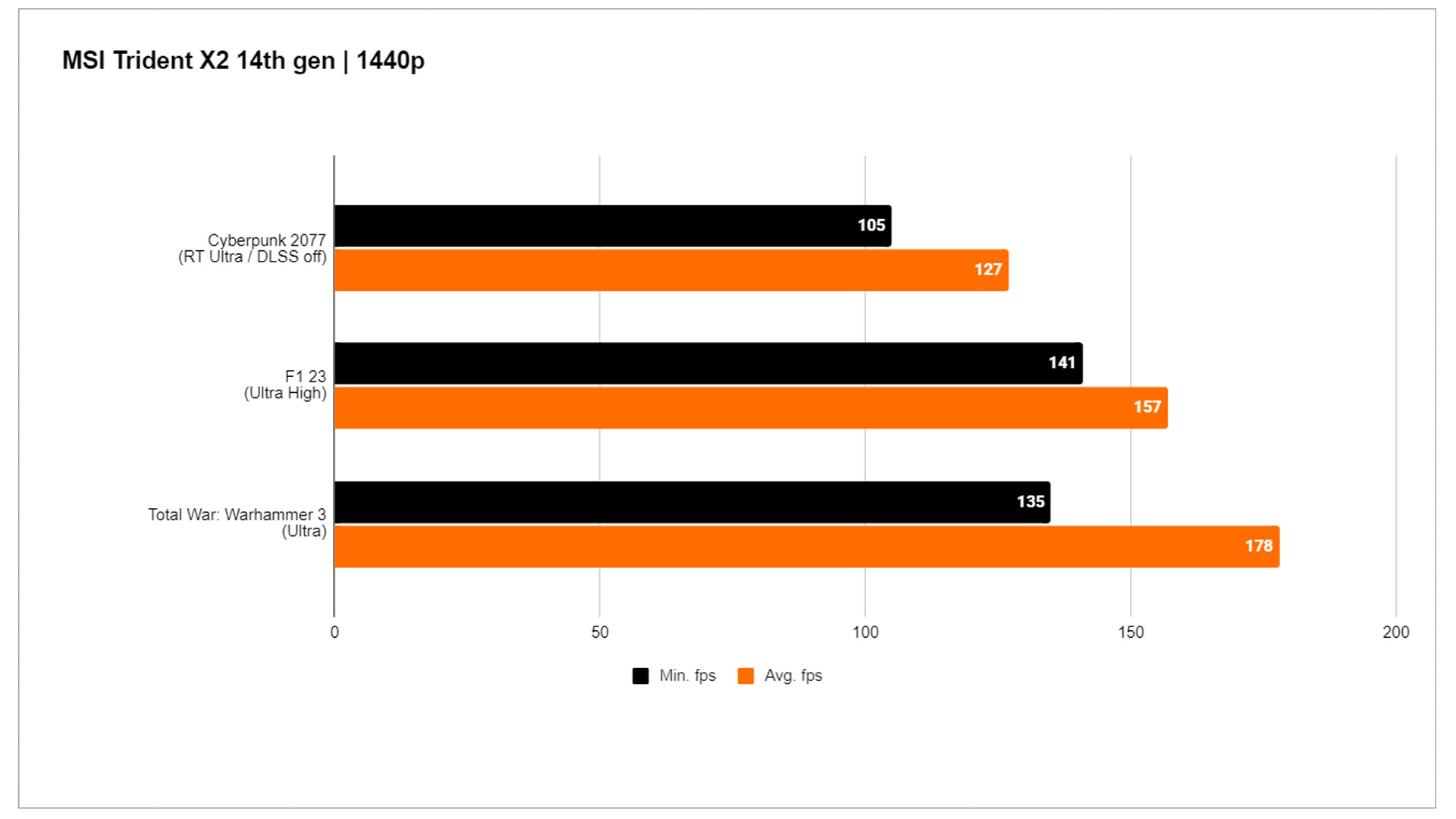
In terms of cooling and noise, this PC is very impressive too. Out of the box the system was set to the Extreme mode, which resulted in the system being really noisy under any sort of load. The fan noise is a steady, relatively low-pitched whoosh rather than being high-pitched, but it was clearly noticeable even with gaming headphones on.
However, switching to the Silent mode made the system whisper quiet under all conditions. Choosing the Balanced mode made the fans spin up to be loud sometimes, but it’s still a more measured option than the extreme noise made by the Extreme mode.
Crucially, the main culprit appeared to be the two fans on the AIO cooler more than the GPU’s fans. As such, any time CPU load settled down, Balanced mode maintained a low noise level. Conversely, it’s the fact that Extreme mode keeps the CPU set at top speed all the time that means it basically never shuts up.
Using a decibel meter, I measured the noise output in Silent mode at 36dB from a distance of 30cm/1ft from the PC. This was during the middle of a game benchmark run where CPU load is modest. During game loading, where there’s more CPU load, this jumped to 40dB. Meanwhile, in Balanced mode this jumped to around 46dB during game loading and 43dB during gaming.
The slight downside to choosing the Silent mode is that it does impact performance. In our Cyberpunk test, we saw average frame rates drop from 126fps to 85fps. The drop was far lower in F1 2023 (142fps to 114fps) and Total War (178fps to 155fps) but was still sizeable. Likewise, in PCMark there was a big drop from a total score of 10,076 to just 5,721.
Conversely, switching on Extreme mode did boost frame rates and other benchmark scores a little compared to Balanced mode, but only one or two fps, although the jump from 9,824 points to 10,014 points in 3DMark Speed Way was a little larger. Overall, though, it’s clear that Balanced is the best option.
One final consideration is power consumption. In Balanced mode the PC consumed a colossal 815W of power during our Cyberpunk benchmarks, and this rose even further to 915W in Extreme Mode.
MSI MEG Trident X2 price
The spec of this PC that we’re reviewing is very expensive simply because it has two of the most expensive PC components you can buy jammed into it. However, for the spec on offer, it actually offers decent value. A similar-spec version of the Maingear MG-1 Ultimate, for instance, costs around the same price. The main reason to consider alternative options would be the greater customization on offer – these MSI systems aren’t configurable. You get a fairly basic one-year warranty via MSI but with a lifetime’s tech support via Excalibur PC.
MSI MEG Trident X2 review conclusion
The MSI MEG Trident X2 is a decent gaming PC for those seeking reliable performance over outlandish RGB-filled looks. MSI has given it an interesting angular design, and added a small touchscreen on the front, but the overall feel is still mainly one of a PC that you’re probably not going to be showing off to your friends.
Its performance will depend on the specs of the version you buy – as with any pre-built PC – but the balance of this top-tier configuration is decent. MSI has partnered top end Intel CPU and Nvidia GPUs with plenty of RAM and a quality motherboard. The storage configuration is the only slight let down, with a 2TB SSD and 2TB hard drive feeling a bit weak for this caliber and price of this machine.
MSI MEG Trident X2 alternatives
Maingear MG-1 Silver
If you’re looking formore of a bespoke gaming PC with a glass-paneled RGB-filled look, there are many PC builders from which to choose. However, the Maingear MG-1 Silver is a great place to start. The version we tested lacks the high-end hardware of this MSI system, but you can specify beefier components. Plus, you can even add your own custom artwork to the case.